Georgia Smith MBCS reports on the Design Education Trust’s INTERPLAY competition, which celebrates the best and brightest creative projects at the intersection of science and aesthetics. She also speaks to the Design Education Trust’s Alec Robertson about what went into selecting the winner, his personal philosophy on arts education, and the goals of the Design Education Trust.
The Design Education Trust is a charity which aims to promote education in creative disciplines by assisting aspiring practitioners to achieve their potential through grants and other related activities. Georgia Smith MBCS talked to trustee Alec Robertson about its goals, ethos and current projects.
The Design Education Trust
So, tell us what Design Education Trust is all about.
The charity was founded by the late John Cox in 2015. He invited me as the design educational expert, and now there are four trustees: myself; Rosemarie Fordham, an arts psychotherapist and artist; Rob and Anne, both accountants; two volunteers, Niki-Marie Jansson MArch, who runs her own design studio and consultancy, and Tere Chad, a Chilean sculptural graduate of the RCA and MA graduate from Central St Martins (UAL).
It's a quite tight team, and hopefully we'll make a bigger impact than our size on design education.
Tell us about what the Design Education Trust is up to now and what your goals are for the year.
The INTERPLAY competition was completed in July with the final Award winner's prototype Exhibit, and we're currently putting this competition material online. We will also sponsor a joint Imperial College - RCA's Cyber-Physical Workshop of the MA/MSc 'Global Innovation Design' and 'Innovation Design Engineering' courses.
INTERPLAY is our biggest venture, and it's probably twice our normal sponsorship. The momentum is there to carry on into the third year with the kinetics idea, mixing engineering and science with design and performance, which is quite a novel perspective that I’m very keen on. Additionally, getting behind this competition could be a bit of a ‘stake in the ground’ for Imperial College London, who run the international Global Innovation Design MA/MSc course together with the Royal College of Art — and they’re an influential school, so to have their enthusiasm could even influence education more widely.
How would you characterise the landscape of design education in the UK at the moment?
We need to encourage art and design education in the UK.
The sector is struggling. Home grown students of arts and design just aren’t funded well now in ordinary UK schools. This means there will be a weak future supply chain for UK higher education arts courses, which are increasingly dependent on overseas applicants.
I have suggested in the past that it’s something of a ‘branding issue’, and the area might benefit from being named something other than D&T. Additionally, we need influential schools to take up the baton, because then other schools think ‘hey, we can do that too’. A top public school, Eton, for example, has a strong Design & Technology course, and Imperial College with the RCA run some fantastic courses.
If schools were willing or able to mix more arts into computing education, then the funding might come in because it is available for computing and technology, and if there was more arts baked into that then at least the students are exposed to it to some extent, and have the chance to develop that interest. The government might then agree to fund it because its ‘applied’, not just pure arts - and then the pupils will get exposure to some extent by doing interdisciplinary courses. But it’s a very difficult area to influence policy in; I throw in my two cents at parliamentary meetings but they’re all focused on AI, and cybersecurity. Not education.
You’re passionate about breaking down educational barriers between disciplines. Why?
The underlying philosophy of what I'm about is that the arts and the sciences pull apart, and they shouldn't. They all deal with dynamic processes and I think that can actually really resonate, but generally they're not allowed to, which means engineering and science projects are often very utilitarian, purely purposeful. The silos of education have not been broken enough; there is far too little synergy between departments, it's structural, and it's a lost opportunity.
“The silos of education have not been broken enough; there is far too little synergy between departments, it's structural, and it's a lost opportunity.”
Say you could have ballet dancers mixing with mechatronics engineers — there could be a resonance there which will add value to industry. Industry at the moment is looking for innovative products, services and ideas, and there's so much potential in just some fresh connections — you get creativity happening just by merging people together and seeing each other's work.
Experience design has come to the fore in the last few years. It’s often nebulously described, but if you're doing anything in a commercial environment, the idea is that it must be enjoyable for customers, not just functional. For example the Santander branch in Leeds has a café now. Going beyond just ‘user friendly’ — which really starts and ends at ‘not problematic’ — and bringing people actual enjoyment when they interact with objects and interfaces is a whole new ball game that would add commercial value as well as social value.
When I visit degree shows at the top colleges, the students are very much captured by current trends, for example sustainability, net zero, or diversity and inclusion. And their projects are all quite utilitarian. They're very hesitant to invest time in the aesthetic side of design. It’s partly influenced by the pressure on tutors and professors to generate income, to get research grants, and they’ve got boxes to tick. Goals like uplifting the spirits of people in the world are not seeing this as a high priority, as productive, which is why the arts are falling by the wayside — but the thing is, when people enjoy what they're doing, they're more productive and happier anyway, so it’s actually economically sensible to invest energy on that. So there’s a lot to be fixed.
Can you speak a bit more about the intersection between aesthetic design and function that the INTERPLAY competition showcases?
As I’ve mentioned, there's very much an educational silo where the sciences and the arts are kept apart. ICL are quite innovative in encouraging cross-pollination; they have courses that try to combine arts and tech in the digital field, and get different people involved. There is no reason that functional things can’t also provide enrichment in the form of beauty or entertainment, and that’s where fusing science and the arts comes in — and that’s the intersection at which INTERPLAY sits.
Ultimately, the best place to see such combinations come to fruition is with everyday technology; for example the designer of the winning piece, Urban Elegance, is a mechanical engineer focused on tracing planetarian movements — but what we actually see will be road and pedestrian signs.
The idea is that even everyday objects, such as traffic lights, don't have to be utilitarian. They can provide something to the community as well, entertain without distracting from the function — and that's the trick.
For you
Be part of something bigger, join BCS, The Chartered Institute for IT.
So what made Urban Elegance the winner?
Urban Elegance’s traffic lights ticked all the boxes; it provided something useful, genuinely functional, and combined it with aesthetic design. The other projects —fantastic as they were — often missed the mark on functionality. For example several other entries were very sculptural objects, which nothing in the brief prevented — but could you transfer the knowledge gains across into everyday things? That’s where a few of them got a bit tenuous.
The Flower Power Tower (FloPoTo) is an example of that. Currently, solar panels only come in one shape; they don't even make a triangular one, such as might fit on a gable. There's nothing really stopping them, they just haven't got the imagination — and that imagination, which FloPoTo has in buckets, is what you gain from merging engineering with the arts and design technology. It allows the aspiration for it to be more than just functional, something people enjoy using or engaging with. So it was a competitor for the top spot, but it wasn't quite realistic enough in the short term — flexible solar power panels are coming along, but it probably wouldn't work at this at this time.
Another competitor, BEAM, have applied to the Innovate UK competition, which offers grants to develop products to consumer levels. It's very competitive — there is £10 million available and any one project can win up to £50,000. So there were some really strong contenders in INTERPLAY.
If people wanted to get involved with the Design Education Trust, how can they do that?
We have a volunteer page and a couple of vacancies for digital volunteers at the moment. Free student mentoring is also something we offer alongside competitions, so that’s something people can get involved with if we do have a competition running.
We’re also open to sponsors — and if someone wants to sponsor a scholarship, for example, we name it after them. We also accept donations – like all charities!
Find out more about the Design Education Trust.
INTERPLAY: featured projects
The INTERPLAY Kinetic Design Competition encouraged students to create projects focused around the ‘kinetic aesthetics of motion’. We constantly interact with objects, and as new technologies abound the built environment becomes ever more dynamic; INTERPLAY celebrates the best and brightest of young creative minds, featuring a range of projects that bring ‘elegant and playful motion design’ into the functional built environment. 14 entries were shortlisted, of which six received commendation awards, and eight were awarded £1000 to develop their ideas.
Winner: Urban Elegance
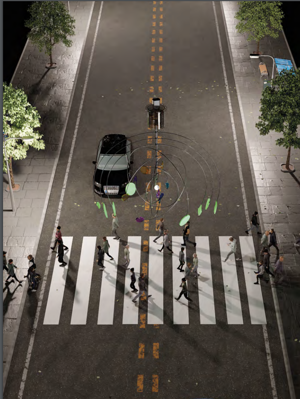
The overall winner, Urban Elegance, was announced during the exhibition and awarded £8000 to develop their idea.
This collaboration between Holly Souza-Newman and Joseph Jones, both students of the joint RCA-Imperial College course ‘Global Innovation Design’, reimagines the humble traffic light. Inspired by the construction of Orrery planetariums, the traffic light aims to ‘breathe life into urban landscapes, transforming ordinary streets into interactive public installations’.
Watch the Urban Elegance presentation
Runners up
Uncanny Dynamics: Kinetics of Constraints
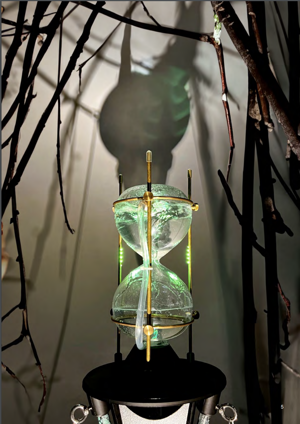
These kinetic sculptures provoke audiences to consider human interventions with nature, and how design can both work with and against natural systems, reflecting on the human relationship with and influence on nature.
BEAM: Bright Emotive Animated Module

BEAM is a living lamp which blends kinetic motion, light, sound, and AI to transform our relationships with everyday objects. Inspired by elegant, biomimetic movements of nature, BEAM creates emotionally rich interactions through intuitive kinetic behaviours, bringing a uniquely graceful and delightfully unpredictable presence to your living space.
FloPoTo
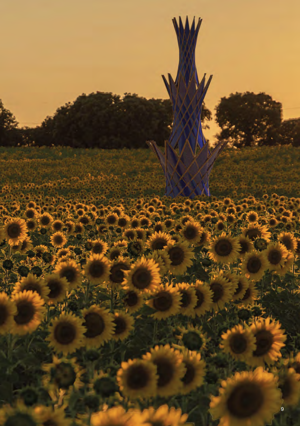
In collaboration with Solar Cloth, the Flower Power Tower is a beautiful automated kinetic solar power unit could potentially revolutionise public acceptance of solar energy technology and bring us one step closer to net zero.
Kinetic Waves: The Ocean Never Speaks Twice

This multisensory kinetic installation, built out of individual pieces of polished metal, perfectly simulates the sights and sounds of moving water through modular, unique wave patterns generated by AI or by human interaction.
The Big Electron
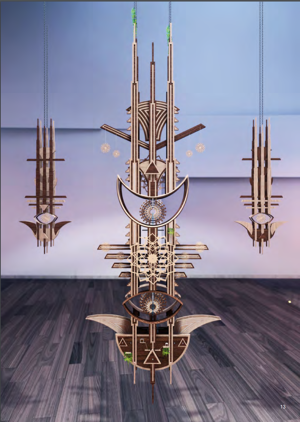
These kinetic sculptures blend modern technology with timeless symbolism, creating captivating sounds, encouraging mindfulness, and offering a glimpse into a future driven by green technologies.
Spectral Objects

An experimental wearable kinetic suit with responsive movements designed register and then to express human personality and emotions.
Parametric Paper
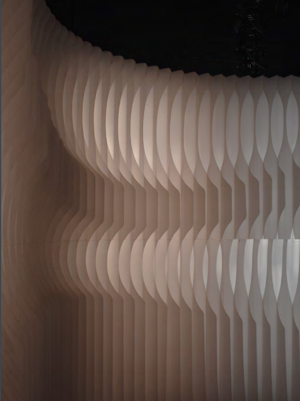
Parametric Paper aims to bring playful and sensorial connections to utilitarian environments through the design of their kinetic sculptures.
We will provide updates on the winning projects: read more about Urban Elegance and BEAM.












